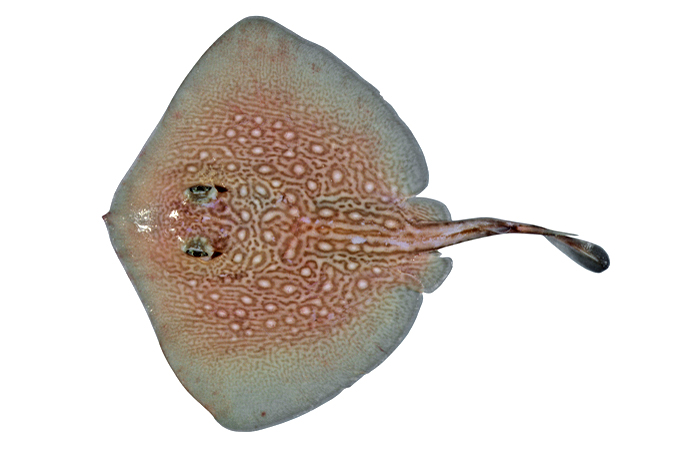- Classification
- CHONDRICHTHYES
- MYLIOBATIFORMES
- UROLOPHIDAE
- Urolophus
- flavomosaicus
Patchwork Stingaree, Urolophus flavomosaicus Last & Gomon 1987
Other Names: Stingaree

Patchwork Stingaree, Urolophus flavomosaicus. Source: Australian National Fish Collection, CSIRO. License: CC by Attribution-NonCommercial
Summary:
A diamond-shaped stingaree with a broad mosaic-like pattern of fine reticulated lines and dark brown rings with pale centres on the upper side, a short flattened tail with a prominent dorsal fin, and a leaf-like caudal fin. This is the largest stingaree species in northern Australia.
The serrated spine is venomous and may inflict a very painful wound.
The serrated spine is venomous and may inflict a very painful wound.
Cite this page as:
Bray, D.J. 2023, Urolophus flavomosaicus in Fishes of Australia, accessed 01 Jul 2025, https://fishesofaustralia.net.au/Home/species/3539
Patchwork Stingaree, Urolophus flavomosaicus Last & Gomon 1987
More Info
|
Distribution |
Endemic to northern Australia from off the Abrohlos Islands, to north of Cape Leveque, Western Australia, and from Townsville to Caloundra, Queensland. Inhabits offshore waters on the continental shelf and upper slope in depths of 60-320 m. Inhabits fine sediment areas, mostly on the outer continental shelf. |
|
Features |
Disc quadrangular, much wider than long; broadest about 1.5 eye diameters behind spiracles; anterior margin broadly rounded. Snout tip slightly extended. Eye small (21-28% precocular snout length). Posterior margin of spiracle acute. Mouth large; about 8 very short papillae on floor. Internasal flap skirt-shaped, posterior angle not lobed. Posterolateral border of nostril flat or forming weak nob, not forming broad flattened lobe. Tail moderately depressed; short (67-79% disc length); lateral cutaneous folds weak, not always obvious; dorsal fin present; caudal fin lanceolate. |
|
Size |
Reaches a total length of at least 325 mm. |
|
Colour |
Dorsal surface yellowish with numerous paler spots encircled by darker yellowish brown rings; spots almost regularly spaced, sometimes interspersed with pale narrow reticulations, largest on central disc. |
|
Biology |
Stingarees are aplacental viviparous, meaning that the embryos emerge from eggs within the uterus and undergo further development until they are born. After emerging from their egg cases, the embryos are initially sustained by their yolk, and later by histotroph, a "uterine milk" produced by the mother. Males mature at about 38 cm TL. |
|
Remarks |
The serrated spine is venomous and can inflict a very painful wound. Common stingarees must be handled with great care. People often get secondary infections from being stung, especially when the barb tip breaks off in the wound. |
|
Similar Species |
This species is among the largest of tropical Australian stingarees. It closely resembles the temperate Urolophus bucculentus, differing in shape, and having very different colour patterns. U. bucculentus is either uniform yellowish or brownish and although it may be covered in fine reticulations and spots, they do not form a broad mosaic pattern. |
|
Etymology |
The specific name is derived from the Latin flavus (= yellow) and mosaicus (= mosaic), in reference to the distinctive colour pattern. |
|
Species Citation |
Urolophus flavomosaicus Last & Gomon, 1987, Mem. Mus. Vict. 48(1): 68, fig. 5. Type locality: North of Port Hedland, Western Australia, 18°20'S, 118°27'E, depth 202 m. |
|
Author |
Bray, D.J. 2023 |
|
Resources |
Patchwork Stingaree, Urolophus flavomosaicus Last & Gomon 1987
References
Allen, G.R. 1997. Marine Fishes of Tropical Australia and South-east Asia. Perth : Western Australian Museum 292 pp. 106 pls.
Daley, R.K., Stevens, J.D., Last, P.R. & Yearsley, G.K. 2002. Field Guide to Australian Sharks & Rays. Hobart : CSIRO Marine Research 84 pp.
Kyne, P.M., Last, P.R. & Marshall, L.J. 2019. Urolophus flavomosaicus. The IUCN Red List of Threatened Species 2019: e.T60093A68649427. https://dx.doi.org/10.2305/IUCN.UK.2019-1.RLTS.T60093A68649427.en. Accessed on 05 September 2023.
Last, P.R. & Compagno, L.V.J. 1999. Family Urolophidae. pp. 1469-1476 in Carpenter, K.E. & Niem, V.H. (eds). The Living Marine Resources of the Western Central Pacific. FAO Species Identification Guide for Fisheries Purposes. Rome : FAO Vol. 3 pp. 1397-2068.
Last, P.R & Gomon, M.F. 1987. New Australian fishes. Part 15. New species of Trygonoptera and Urolophus(Urolophidae). Memoirs of Museum Victoria 48(1): 63-72 https://doi.org/10.24199/j.mmv.1987.48.15
Last, P.R. & Stevens, J.D. 2009. Sharks and Rays of Australia. Collingwood : CSIRO Publishing Australia 2, 550 pp.
Rigby, C.L., White, W.T. & Simpfendorfer, C.A. 2016. Deepwater chondrichthyan bycatch of the Eastern King Prawn Fishery in the southern Great Barrier Reef, Australia. PLoS ONE 11(5): e0156036. https://doi.org/10.1371/journal.pone.0156036


